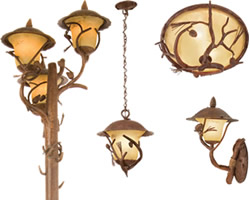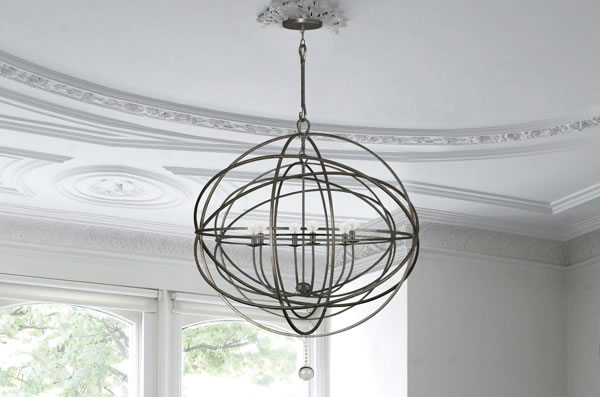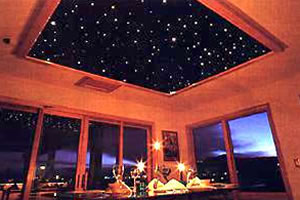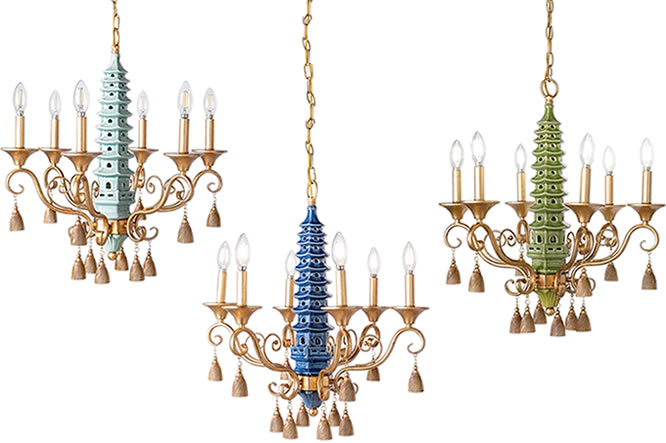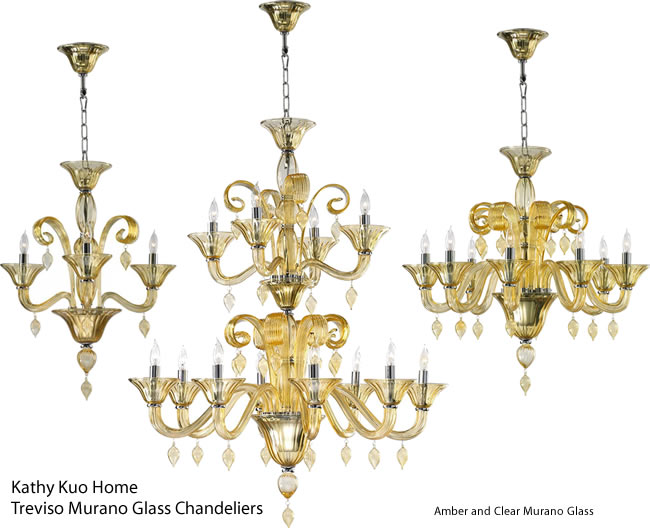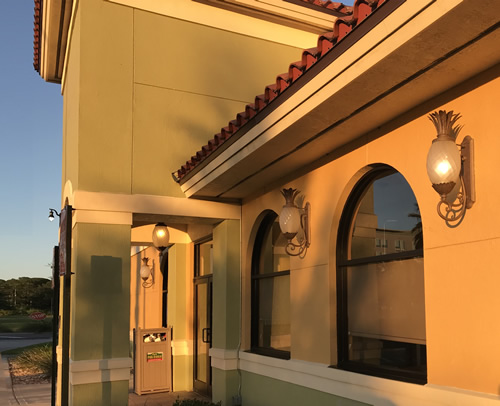DIY Guide to Buying and Designing Cable Light
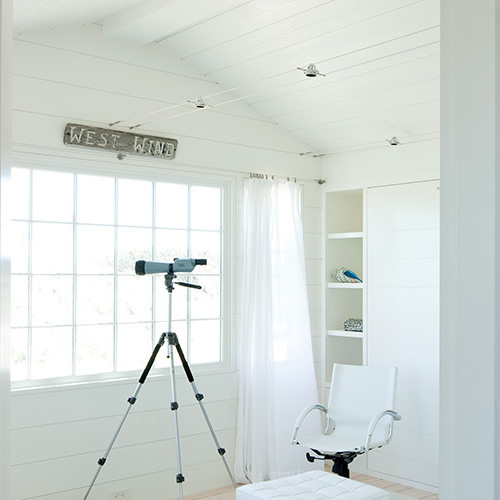
Cable lighting is really pretty simple. It is just two lengths of metal braided wires attached to the walls or the ceiling. A transformer connects to both wires to provide low voltage power. Lights attach to both wires and light up. That’s it.
You can add various standoffs to change direction or supports to run longer distance or support heavier fixtures.
The easiest way to start is a kit. This kit from Tiella, a division of Tech Lighting is a good place to start.
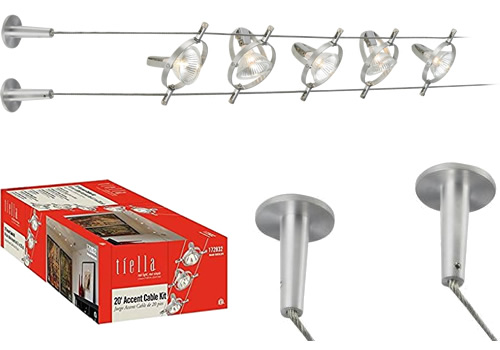
The Tiella 800CBL5PN Cable Kit comes with two 20 foot lengths of cable, four 2” supports, a 100 Watt surface transformer that attaches to the cable with little alligator clips on 12” wires, and five adjustable lights that hold MR16 bulbs. The lights clip onto both cables to provide power.
Tiella 800CBL5P, 800CBL5PN Accent 5-Light Cable Kit on Amazon
The kit ships with five 20 watt halogen MR16 bulbs. The supports and light fixtures are in Matte Nickel finish. The transformer cover is painted white. If you want it to blend in with any other color ceiling or wall, spray paint it before you put everything together.
You can modify these kits or build your own. Here are all the components to design a cable installation.
Cable
Cable for cable kits can be any conductive cable, cable that carries power, as long as it is strong enough to support your lights and not too thick for the lights, connectors and supports. If you use covered wire cable, just pierce it to make a connection. Tech Lighting and Bruck Lighting sell lengths of covered and bare cable designed for cable lighting. Tech Lighting’s Kable cable is #10 gauge, tin-plated copper cable. It is available sheathed in clear insulation. Bruck Lighting’s High-Line Cable is conductive cable composed of stranded copper wiring. It is available with Kevlar to increase tension strength. Both are available with or without transparent insulation. Bruck recommends a maximum run of 17 feet for standard cable or 30 feet max Kevlar stranded cable. Tech Lighting says cables can span up to 20 feet without additional support.
Tech Lighting Kable product numbers
- 700KLABAREC #10 gauge tin-plated copper cable
- 700KLAINSCL #10 gauge, tin-plated copper cable sheathed in clear insulation
Bruck Lighting High Line product numbers
- 150 109 tin plated Kevlar cable
- 150 119 tin plated insulated Kevlar cable
Other companies, like Eurofase, made inexpensive cable kits that use other cable and it works. I don’t know of any of these kits available right now, though.
The cable is attached to the wall or ceiling using attractive turnbuckles or posts. Inexpensive kits sometimes have the cable attached using just hooks.
Cables can be separated from 2″ to 36″. Fixtures are available to span the distance between the cables. You can use standoffs to change the separation between the cables for different areas.
Transformer
The transformer can be surface mounted, covering a standard 4″ junction box, the electric box on the wall or ceiling. Or you can use a remote transformer. A remote transformer can be anywhere. Usually they are in the attic or a closet near the cable setup. Wires come out of the transformer to power the cable runs. A finished Power Feed runs from the remote transformer to each cable.
Transformers have minimum and maximum capacity. The total output wattage of the transformers determines the total wattage of the elements that can be used on the system. For example, a 300 watt transformer can theoretically power up to six 50 watt heads (6 x 50 = 300). The Tiella kit has a 100 watt transformer and runs five 20 watt halogen MR16 lamps. I’m guessing Tech Lighting gives you the actual wattage the transformer can power. More commonly transformer companies give you the wattage of the transformer. You need to “round down.” Usually, a 300 watt transformer should actually only power at 80% of capacity. That means that A 300 watt transformer will only power 240 watts. Just do the math.
Don’t forget about the minimum capacity. If you are using LED lamps, they draw very little power. Some transformers just don’t work well that way. An LED driver is a transformer without a minimum requirement specifically for LED lamps. If you use LED lamps instead of halogen and you don’t want to change your transformer, just use more lamps or add back in a halogen or two if you have buzzing, browning out, dimming or flickering. If you look at your transformer, it likely has the minimum and maximum printed right on it.
If you are designing your system from scratch, you need to figure out which transformer you need. Add up the wattages of the lamps you’ll be using on the system. LED lamps use very little power. You can use LED bulbs and add way more light without buying a more expensive powerful transformer. I can’t promise this will work for you, but people seem to do it all the time.
Electronic transformers and low voltage LEDs?
… the self oscillating part of the circuit is driven by the surge of energy caused by the load it’s supplying. This energy goes through a tiny feedback toroid transformer and is cleverly used to drive the base terminal of the power transistors, directly driving the oscillation. If there is no load on the electronic transformer’s output, there will be insufficient energy to drive the oscillator feedback toroid. Consequently, it will not oscillate and subsequently it cannot transform the volts.
It is not so good if you’re trying to retrofit LED lights though, especially if they do not reach the minimum load requirement of the electronic transformer.
www.cycloflow.com/2014/05/electronic-transformers-and-low-voltage.html#minimum_load
Transformers come in Magnetic or Electronic. A magnetic transformer is usually less expensive if you are powering a lot of lights. If you decide to use a magnetic transformer, a debuzzing coil can reduce or eliminate the hum.
Most lower priced cable systems are 12 volt, although some fixtures will run perfectly well on 24 volts. 12 volts run systems up to 30 feet, which is adequate for nearly any place you want cable. 24 volts gives you cable runs up to 60 feet (with additional supports).
Tech Lighting makes transformers that are specifically for cable.
Bruck Lighting High-Line Cable uses the same transformers as the rest of their systems. They have Power Feeds that are finished to run from the remote transformer to each cable.
Tech Lighting Kable Power Feeds and Transformers >
Dimmer
Make sure you use the right dimmer for your Magnetic or Electronic transformer. Using the wrong dimmer will make the transformer make a loud hum and it will eventually fail.
Connectors and Standoffs
Connectors can be as simple as hooks to hold the cable up. Riggers allow you to support cable running parallel to a wall.
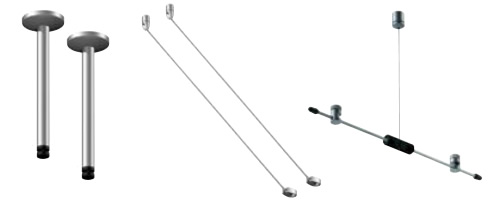
These are just some of the supports and riggers Bruck Lighting offers.
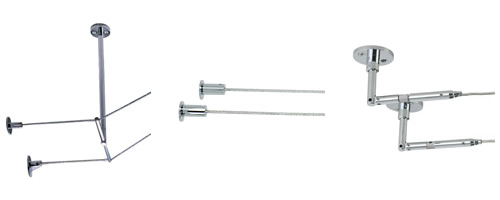
Tech Lighting has an even wider selection of components to support longer or heavier installations, mount the track from the walls or ceiling or change directions vertically, diagonally or horizontally.

Cheap lighting kits come with simple hooks. That works, too.
Using different components you can change directions, make sharp turns or change the height, running either up or down at an angle using various standoffs. You can change the space between the cables, too.
Standoffs can also help to support the cable if you are going a longer distance or using heavy lights or pendants.

Lights
There is a huge variety in lights available for cable systems. They come in different widths, for cable separations from 2″ to 36″.
Light weight pendants can be suspended from cable. Some come with the connecting components already part of the pendant.
You can also adapt lights for other systems to work on cable using a Freejack connector from Tech Lighting or a uni-plug adapter from Bruck Lighting. Because the cable is the same size, the lights are compatible. However, if you want a very consistent look, choosing lights all from the same company will make sure they all have the identical finish.
Cable Lights – DIY Guide to Buying and Designing Cable Light Part 2 >
Cable Pendants – DIY Guide to Buying and Designing Cable Light Part 3 >

